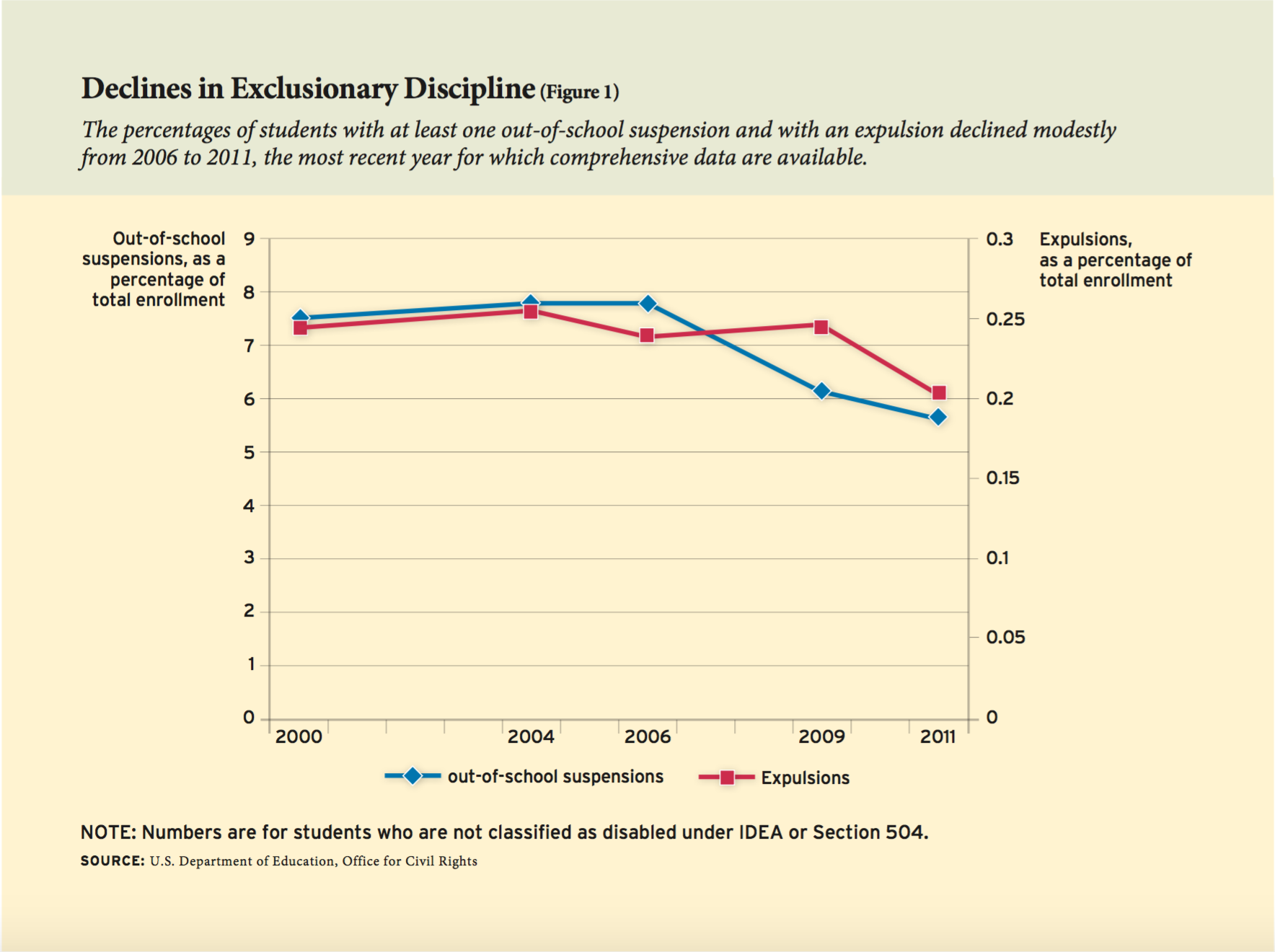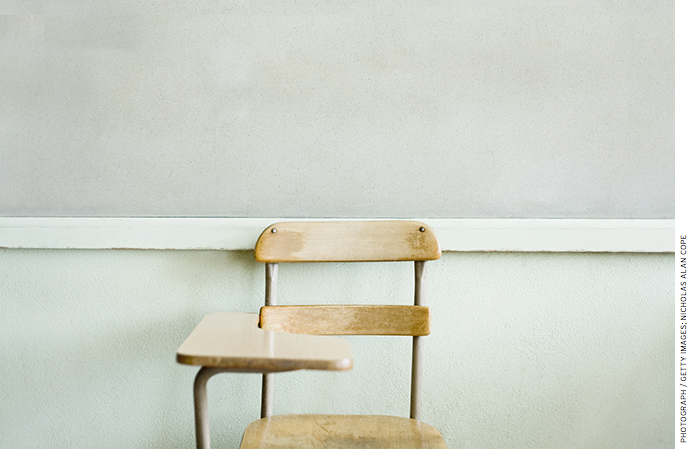
The U.S. Department of Education’s Office for Civil Rights announced this spring that the number of suspensions and expulsions in the nation’s public schools had dropped 20 percent between 2012 and 2014.
The news was welcomed by those who oppose the frequent use of suspensions and expulsions, known as exclusionary discipline. In recent years, many policymakers and educators have called for the adoption of alternative disciplinary strategies that allow students to stay in school and not miss valuable learning time. Advocates for discipline reform contend that suspensions are meted out in a biased way, because minority students and those with disabilities receive a disproportionate share of them. Some also assert that reducing suspensions would improve school climate for all students.
Government leaders have taken steps to encourage school discipline reform. The Obama administration has embarked on several initiatives to encourage schools to move away from suspensions and toward alternative strategies. In 2011, the Department of Education (DOE) and the Department of Justice (DOJ) launched the Supportive School Discipline Initiative to coordinate federal efforts in this area. In January 2014, the DOE released a resource package with a variety of informational materials designed to support state and local efforts to improve school climate and discipline. The package included a “Dear Colleague” letter, issued jointly by DOE and DOJ, warning against intentional racial discrimination but also stating that schools unlawfully discriminate even “if a policy is neutral on its face—meaning that the policy itself does not mention race—and is administered in an evenhanded manner but has a disparate impact, i.e., a disproportionate and unjustified effect on students of a particular race.”
Discipline reform efforts are also underway at the state and school-district levels. As of May 2015, 22 states and the District of Columbia had revised their laws in order to require or encourage schools to: limit the use of exclusionary discipline practices; implement supportive (that is, nonpunitive) discipline strategies that rely on behavioral interventions; and provide support services such as counseling, dropout prevention, and guidance services for at-risk students. And as of the 2015–16 school year, 23 of the 100 largest school districts nationwide had implemented policy reforms requiring nonpunitive discipline strategies and/or limits to the use of suspensions. In an April 2014 survey of 500 district superintendents conducted by the School Superintendents Association (AASA), 84 percent of respondents reported that their districts had updated their code of conduct within the previous three years.
What evidence supports the call for discipline reform? How might alternative strategies affect students and schools? In this article, we describe the critiques of exclusionary discipline and then examine the research base on which discipline policy reform rests. We also describe the alternative approaches that are gaining traction in America’s schools and present the evidence on their efficacy. Throughout, we consider what we know (and don’t yet know) about the effect of reducing suspensions on a variety of important outcomes, such as school safety, school climate, and student achievement.
In general, we find that the evidence for critiques of exclusionary discipline and in support of alternative strategies is relatively thin. In part, this is because many discipline reforms at the state and local levels have only been implemented in the last few years. While disparities in school discipline by race and disability status have been well documented, the evidence is inconclusive as to whether or not these disparate practices involve racial bias and discrimination. Further, the evidence on alternative strategies is mainly correlational, suggesting that more research is necessary to uncover how alternative approaches to suspensions affect school safety and student outcomes.
Addressing such questions is vitally important, because a safe school climate is essential for student success. A recent National Center for Education Statistics report documented downward trends in suspensions, student victimization, and reports of bullying. Since 2006, out-of-school suspensions have declined, with more recent declines in expulsions (see Figure 1). Still, more than one-third of teachers in 2012 reported that student behavior problems and tardiness interfered with their teaching. Regardless of the kind of discipline districts choose to employ, policymakers and school leaders must recognize that school disorder and violence have adverse effects on all students. For example, students who were exposed to Hurricane Katrina evacuees with significant behavior problems experienced short-term increases in school absences and discipline problems themselves. Recent evidence also shows that exposure to disruptive peers during elementary school worsens student achievement and later life outcomes, including high school achievement, college enrollment, and earnings (see “Domino Effect,” research, Summer 2009). These findings highlight the importance of closely monitoring the effects of discipline reform on all students.
Critiques of Exclusionary Discipline
Disproportionate suspension rates. There is little doubt that students of color and those with disabilities face exclusionary discipline much more often than their peers do. Racial disparities in suspensions begin as early as preschool, with black children comprising 18 percent of enrollment in preschools but 48 percent of preschool children experiencing one or more suspensions, according to the federal Office for Civil Rights. These disparities extend through primary, middle, and high school, where black students comprise 16 percent of all enrolled students but 34 percent of students suspended once (and 43 percent of students receiving multiple out-of-school suspensions) (see Figure 2). Furthermore, gaps in suspension rates between black students and white students have grown over time, doubling between 1989 and 2010. Youth enrolled in special education also experience higher rates of suspension: in 2011, students with disabilities were suspended at twice the rate of nondisabled students.
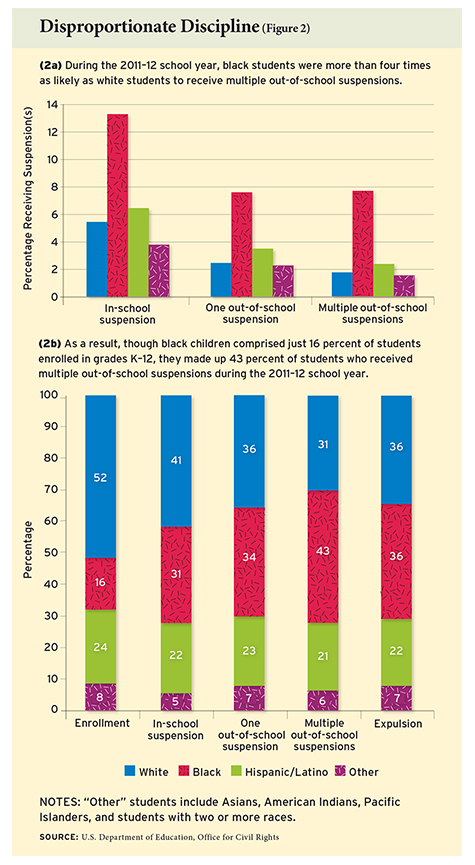
What accounts for these disparities? Do they stem from discrimination and racial bias? The possibility of such bias is one justification for the Office of Civil Rights’ involvement in the issue of school discipline. However, it could be that special-education and minority students are disciplined more often because they commit more infractions than their peers. If that is so, the greater frequency of violations among minority students could be caused by factors outside of the school’s purview, such as more exposure to poverty, crime, and life trauma resulting from residential and economic inequality. Many disabled students also face heightened life stresses that could contribute to misbehavior.
Some evidence does suggest that students with disabilities and racial minorities tend to be punished more severely than their peers for the same offenses. In 2011, Russell Skiba and colleagues analyzed school-level data on disciplinary referrals in 364 schools and found that black and Hispanic students were more likely than white students to receive suspensions or expulsions for “minor misbehavior,” such as inappropriate verbal language, minor physical contact, disruption, and defiance. Unfortunately, the study was unable to control for students’ prior infractions in school, a factor that may influence the severity of the response to a given offense. In a separate study, Russell Skiba and Natasha Williams further revealed that black students in the same schools or districts were not engaged in levels of disruptive behavior that would warrant higher rates of exclusionary discipline than white peers.
Recent evidence from Arkansas confirms that black students attending public schools there are punished more harshly than their white peers, but also suggests that most of the difference is attributable to the schools that students attend. Researchers found that, over the course of three school years, black students received, on average, 0.5 more days of punishment (including in-school and out-of-school suspension and expulsion days), even when controlling for special-education status and comparing students at the same grade level. However, they showed that cross-school differences explained most of this aggregate difference; that is, when the researchers looked only at students attending the same school, the racial differences became much more modest, with black students receiving only about 0.07 more days of punishment than whites. Within schools, the authors also found a statistically significant, though modest, difference in the length of punishment for special-education students, approximately 0.10 days more per suspension.
One recent study using nationally representative longitudinal survey data considered the role of prior problem behavior in disparate suspension rates. When the study authors controlled for whether these students exhibited prior behavioral problems (in kindergarten, 1st, and 3rd grades), they found that the racial gap in 8th-grade suspension rates disappeared, leading them to conclude that the disproportionate use of suspensions was probably not the result of racial bias. This conclusion is subject to question, however, since the authors compared results from statistical models that relied on different underlying samples, owing to student attrition within the study. Further, the study was unable to address any biases implicit in the measure of prior behavioral problems; nor did it consider that a child might be labeled as a “troublemaker” early on, which might predispose authorities to mete out harsher consequences.
One of us (Steinberg) has shown that schools in Chicago serving students from communities with lower poverty and crime rates tend to be safer schools, especially where there are social resources available in the community. Furthermore, schools serving students from neighborhoods with the highest crime rates and the fewest social resources predominantly serve African American students; thus, most of the schools in Chicago where students and teachers report the lowest levels of safety serve a majority African American student population. These findings suggest the need for increased attention to how neighborhood disadvantage influences student conduct, and for policymakers and school leaders to consider the kinds of school resources that could support students facing adverse home and community circumstances.
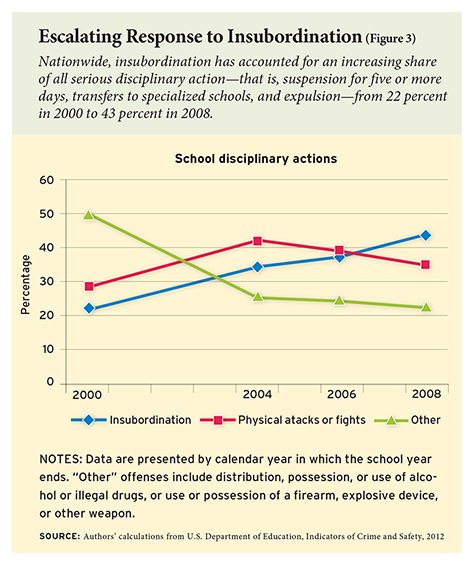
Overuse of suspensions for minor offenses. Critics also say that exclusionary discipline is used too frequently in response to lower-level, nonviolent student behavior. For example, nearly half of all suspensions issued in California public schools during the 2011–12 school year were for “willful defiance,” a category of student misconduct that includes refusing to remove a hat or turn off a cell phone, or school uniform violations. Nationwide, insubordination has accounted for an increasing share of all serious disciplinary actions—that is, suspensions for five or more days, transfers to specialized schools, and expulsion—from 22 percent during the 1999–2000 school year to 43 percent in 2007–08 (see Figure 3). Over the same period, the proportion of serious disciplinary actions for more serious student misconduct (such as possession of alcohol, drugs, or a weapon) declined from 50 to
22 percent.
Negative effects on school climate. Advo-cates of discipline reform contend that exclusionary discipline may have adverse consequences for school climate. While zero-tolerance policies aim to improve school climate and safety by removing disruptive students, research evidence finds that teachers and students in schools with high suspension rates report feeling less safe than their counterparts in schools serving similar students that have lower suspension rates. Schools with higher suspension rates also have greater teacher attrition and turnover. According to the American Psychological Association’s Zero Tolerance Task Force, there is no hard evidence that exclusionary policies reduce school violence.
While the evidence does suggest that school climate is worse when exclusionary discipline practices are more widespread, this evidence is not causal. We don’t know whether the use of exclusionary discipline causes school climates to deteriorate, or if administrators respond to unruly climates by clamping down on school discipline. Therefore, policymakers and practitioners must remain cautious about the potential effects that newly implemented reforms may have on school climate and student safety. And even if schools reduce their use of exclusionary practices, it doesn’t necessarily follow that they will cease to mete out these punishments disproportionately by race.
Negative effects on student outcomes. Critics also contend that exclusionary discipline can trigger a downward spiral in students’ lives inside and outside of school, leading to the so-called school-to-prison pipeline. Unfortunately, research on the causal effect of suspensions on academic achievement and other student outcomes is limited. Students who are removed from school do tend to have lower achievement on standardized exams; are less likely to pass state assessments; and are more likely to repeat a grade, drop out of school, and become involved in the juvenile justice system. The AASA’s 2014 survey found that 92 percent of superintendents believe that out-of-school suspensions are associated with negative student outcomes, including lost instructional time and increased disengagement, absenteeism, truancy, and dropout rates. These correlations, however, do not tell us whether suspended students would have experienced these adverse outcomes even if they hadn’t received suspensions.
Alternative Practices
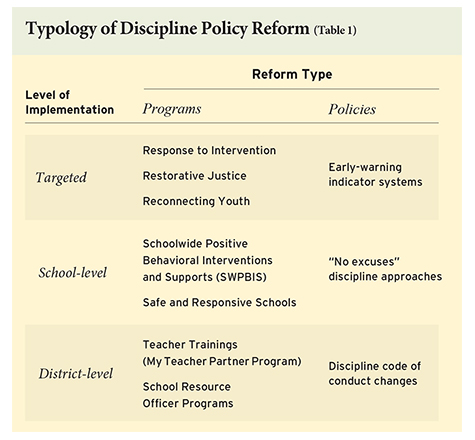
What are the alternative approaches to exclusionary discipline that are currently being implemented? And what is the evidence that they “work”—that is, do they reduce suspensions and expulsions without leading to increased disorder or violence?
Discipline reforms fall into two main categories: programs and policies. Some reforms are implemented at the district or state level, some at the school level, and some are targeted directly toward specific individuals or groups of students. Table 1 provides an overview of reforms by type and level of implementation.
Which of these alternatives are most effective at reducing suspensions and improving student outcomes? Some of the approaches are “evidence-based,” meaning they have been the subject of evaluation research that can support causal conclusions about their effectiveness. However, many have yet to be rigorously evaluated. As reform efforts quickly outpace research evidence, many administrators, teachers, and policymakers are left to wonder: Are the new approaches having the intended effect? And what unintended effects might they have on students?
Program-Based Interventions
Targeted programs. Programs that use the Response to Intervention (RTI) model provide services to specific youth, with the goal of preventing further behavioral problems by responding to behavioral issues as they arise. A key goal of the approach is to tailor the intervention to the student: if a student does not appear to respond to a given approach, a more intensive intervention is applied. While one case study by Sarah Fairbanks and colleagues in 2007 suggests that office referrals decreased following implementation of RTI, and teachers rated student misbehavior to be less intense and less frequent, few rigorous evaluations of RTI have been conducted.
Another targeted program, restorative justice, uses peaceful and nonpunitive approaches to address misbehavior and solve problems in school. While rigorous evidence on the causal impact of restorative justice on student outcomes is scarce, Trevor Fronius and colleagues reviewed the descriptive literature and found that all studies documented decreases in the use of suspensions, expulsions, or violent student behavior, as the program was implemented.
Some programs combine multiple approaches, such as the Preventing Recidivism through Opportunities, Mentoring, Interventions, Supports, and Education (PROMISE) program in Broward County, Florida. PROMISE employs both restorative justice principles and an RTI approach to promote conflict resolution and prevent gang involvement, drug use, and violence among students. Qualitative research by Joan Collins-Ricketts and Anne Rambo suggests that PROMISE is associated with lower suspension rates. However, given the lack of empirical evidence on the program, we cannot discern whether such outcomes result from PROMISE or from other, independent factors. Nor do we know about the impact of the program on school climate, order, and safety—or outcomes for students in general.
Not all studies of targeted programs show promise. The Reconnecting Youth program provided classroom-based instruction for high school students at risk of dropping out or who exhibited problematic behavior. Hyunsan Cho and colleagues conducted an experimental study of the program’s impact and found no significant effect on delinquency immediately following the intervention or at the six-month follow-up.
School-based programs. Schoolwide Positive Behavioral Interventions and Supports (SWPBIS) takes a “systems approach,” targeting a school’s overall social culture and providing intensive behavior supports, such as functional behavioral assessments, identifying contexts where behaviors occur, and teaching communication, social, and self-management skills, as needed. The approach aims to change school culture by setting clear behavioral expectations, designing a continuum of consequences for infractions, and reinforcing positive behavior. SWPBIS is one of the only interventions supported by strong evaluation research. Multiple experimental studies, including those by Catherine Bradshaw and Robert Horner and their colleagues, find that SWPBIS decreases school suspensions and improves student perceptions of school safety.
While SWPBIS focuses primarily on building social and emotional skills, the Safe and Responsive Schools (SRS) project aims to reduce school violence and improve student behavior. SRS focuses on preventative efforts, such as conflict resolution and crafting a civility code, and on developing specific responses to disruptive behaviors, such as behavior-support classrooms as an alternative to office referrals. A descriptive analysis of four schools using SRS conducted by Russell Skiba and colleagues in 2006 found overall decreases in suspensions from the first year of SRS implementation to the end of the fourth year, with larger decreases in suspensions for students with disabilities.
District-level programs. Programs at the district level often involve redefining how teachers and school resource officers (SROs) interact with students. (An SRO is a law enforcement or security officer assigned to a school who has the ability to make arrests and respond to calls for service.) Teacher training programs, such as the My Teacher Partner Program (MTP), provide support for teachers to reflect on interactions with students and develop strategies to address behavior issues to achieve positive outcomes. One experimental study in 2014 by Anne Gregory and colleagues found that teachers in the MTP program suspended students less often than teachers in the control group, and when suspensions did occur, MTP teachers had equal suspension rates for African American and white students.
Another district-level approach involves working with SROs to improve interactions with students and prevent the escalation of school-based incidents that are referred to juvenile court. SRO programs can provide training for SROs in cultural competence and teen psychology; forge agreements between districts, family courts, and police departments to resolve discipline issues using alternative strategies; and limit the ability of SROs to arrest students. Some school districts have reported decreases in court referrals after implementation of SRO programs, especially for minority students, but there is little rigorous evidence on the efficacy of this approach.
Policy-Based Interventions
In contrast to programmatic approaches, some reforms involve changing the policies that guide districts, schools, and teachers as they respond to student misbehavior.
Targeted policies, such as early-warning indicator systems, use large administrative databases to systematically predict which students will struggle with academics or behavioral problems, with the intention of targeting those students early, before problems escalate. While little impact-evaluation research exists on the efficacy of early-warning indicator systems in reducing the use of exclusionary discipline, implementation research suggests that if early-warning systems are not paired with a behavioral-support approach, they are unlikely to be effective.
School-level policies. Schoolwide disciplinary codes, such as the “no excuses” policies employed in KIPP schools, aim to set high behavioral expectations for all students. Under such a policy, students often receive detentions for minor infractions (such as uniform violations) and automatic suspensions for other offenses. While this approach would seem to resemble an exclusionary policy, it aims to remove a sense of unfairness from the disciplinary scheme by holding all students to uniformly high standards. Evidence on the impact of no-excuses discipline on student behavior and suspensions is rigorous, but results are mixed. Two recent studies, one by Joshua Angrist and colleagues and another by Matthew Johnson and colleagues, found that attendance at urban charter middle schools with high behavioral expectations is associated with a higher number of days suspended relative to attendance at traditional schools in the same districts. Another study by Philip Gleason and colleagues found no difference in suspensions between charter school attendees and students who did not win the admissions lottery. A fourth study by Christina Tuttle and colleagues found no difference in student perceptions of the disciplinary environment among middle school KIPP lottery winners relative to lottery losers.
District-level policies. Changes to district policies guiding school discipline and student conduct constitute a direct approach to reducing exclusionary discipline. Many states and districts across the country have revised their student codes of conduct in recent years to remove harsh responses to minor disciplinary infractions and shorten the length of suspensions. Revising student codes of conduct to reduce the use of suspensions, particularly for lower-level offenses, shows promise as a strategy to reduce suspension usage (as in a study we conducted in Philadelphia). Notably, new evidence from Nick Mader and colleagues in Chicago finds that there may be few (if any) costs to school climate associated with reducing the length of out-of-school suspensions for more serious student misconduct. Ninth-grade students there reported neither increases in bullying behavior nor a worsening of peer relationships in the year the code of conduct reform was implemented. In fact, students reported that student-teacher trust improved by the second post-reform year.
Looking Ahead
Across the country, disciplinary programs and policies are trending away from exclusionary practices and toward a variety of alternatives, with the endorsement of federal and state governments. Yet the evidence base about the harm caused by suspensions, and the potential benefits of other approaches, is surprisingly thin. Clearly, there is a great need for rigorous evaluation research, which should focus both on the impact of school discipline reforms and on their potential unintended consequences.
Future research should address some key questions. First, is the reform an effective approach to reducing suspensions? Has it been implemented with fidelity? Second, even if reforms succeed in decreasing the number of suspensions, do they also succeed in reducing disproportionate suspension rates by race and disability? Descriptive evidence from Buffalo, New York, suggests that they may not. A report by Citizen Action of New York in 2015 found that after the district reformed its code of conduct to limit suspensions for nonviolent and minor misbehavior, the use of short-term suspensions decreased in 60 percent of Buffalo’s public schools, and long-term suspensions dropped in half of them. Yet black and Hispanic students continued to receive 80 percent of all suspensions, and were 6.5 and 3.7 times more likely to be suspended than white students, respectively.
Third, what are the impacts of discipline policy reforms on students who are disciplined, and do reforms have “spillover” effects on their peers? Making significant changes to codes of conduct or implementing programs to shift the culture of a school may cause difficulties for teachers and students, at least in the short term. Evidence from Chicago indicates that, following a district reform aimed at reducing the length of suspensions for more serious offenses, school attendance increased among disciplined students with no adverse effect on the attendance of their peers. Though the increase in school attendance among disciplined students led to only very modest improvements in their academic performance on state reading exams, it did not have a substantively negative effect on their peers’ academic performance.
With further research focused on these key questions, we may come to better understand the implications of discipline policy reforms—how they affect suspension use, and also how they change school climate; interactions among students, peers, and teachers; and the academic performance of all students. Children need a safe, secure learning environment if they are to thrive in school. Until we fully understand the benefits and costs of the various approaches to discipline, both exclusionary and alternative, we will fall short of providing that supportive climate.
Matthew P. Steinberg is assistant professor at the University of Pennsylvania’s Graduate School of Education. Johanna Lacoe is a researcher at Mathematica Policy Research.
Download a version of this piece with full citations here.
This article appeared in the Winter 2017 issue of Education Next. Suggested citation format:
Steinberg, M.P., and Lacoe, J. (2017). What Do We Know About School Discipline Reform? Education Next, 17(1), 44-52.


